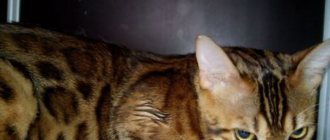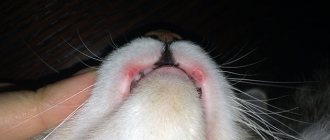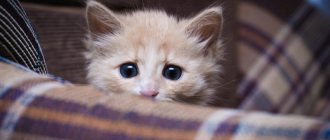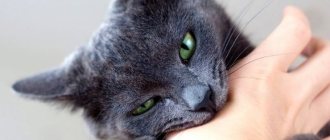If a cat falls from a height and lands unsuccessfully, then injury and bruise cannot be avoided. Of course, the health of the animal is not threatened by jumping from a cabinet, table, bed or tree. But if a cat fell out of a window from the fifth floor or even from the third, there is a high probability of fractures, concussion, and damage to internal organs. Therefore, if a cat accidentally falls from a great height and has characteristic signs of damage, it is necessary to urgently take the pet to the veterinary clinic.
Cats falling from a height - treatment in the clinic
A cat came into the house as a sign: what is it for and what to do
After conducting research and making a diagnosis, a suitable treatment is selected. At the first stage, the cat is given special sedatives to relieve the state of shock and relieve the animal from stress. Severe nervousness leads to disruption of the functioning of all organs.
If necessary, surgery is prescribed to eliminate internal damage. In case of fractures, the bone tissue is connected and plaster is applied.
If you have a traumatic brain injury, you may need to use a ventilator.
The animal is prescribed a number of suitable medications that will help rapid recovery, and droppers with medicinal solutions are placed. The cat's condition is monitored daily.
For fractures, plaster is applied to the damaged areas
How to prevent a cat from falling out of a window
Cats love heights, so they don't feel much fear. The result is often falls and serious injuries. It is possible to protect an animal from such a situation by following safety rules:
The safety of the animal depends on the owner
- If the animal likes to sit on the windowsill, then it is recommended to take care of durable mosquito nets that can withstand serious pressure.
- Nets should also be placed on the balcony to prevent the possibility of falling from it.
- When leaving the apartment, be sure to check all the windows; in the absence of the owner, cats become even more curious.
- If your pet experiences falls from the bed, cabinets, or other places while sleeping, you should contact your veterinarian for an examination. Perhaps this is a sign of some disease.
If a cat falls from a height, then in most cases the fault lies with the owner. Inattention and absent-mindedness lead to similar consequences. The injured animal is carefully and quickly taken to the hospital for diagnosis and selection of the most appropriate treatment. Following preventive measures will help avoid accidents.
XXI CENTURY Candy Fudge Scented water
266 ₽ More details
Video baby monitor Motorola MBP36S (white)
12900 ₽ More details
Men's clothing size 56
What are the dangers for a cat falling from a height?
First, small animals have a different weight-to-skeletal strength ratio than humans. Therefore, cats survive falls from heights much easier than us.
The height of three floors for a cat is not height at all. Due to the “spring” paws, the animal does not receive damage.
A fall from a height of up to five floors can result in a slight fright if the cat lands on the lawn or in a snowdrift.
If the height was greater, or the cat fell on a hard surface, injuries could not be avoided. Such a fall is fraught with:
- broken limbs - the cat lands on its paws;
- head injuries are the next part of the body to be hit;
- concussion;
- spinal injury;
- bruises of internal organs;
- internal bleeding;
- shock.
Cats and Asher cats are considered the most expensive in the world.
Find out how to properly feed your domesticated decorative rabbit from this article.
How nature helped the cat
A cat usually survives a fall well without serious injury. When an animal loses support under all four limbs, the reflex balance system triggers the following protective mechanisms:
- The animal's paws will be placed to the sides of the body, which creates additional windage and, accordingly, a decrease in acceleration.
- To avoid damage to internal organs and the head, a healthy animal always falls with its paws down.
- The tail will spin like a propeller, providing deceleration and some maneuverability, which helps the animal coordinate its landing.
The cat received all the reflexes described above from its wild ancestors, who, being true predators, obtained food in pursuit of birds, for which they had to climb trees. Among other things, the anatomy of the carpal and metacarpal joints in this species is formed in such a way that the vertical load on the overlying bones of the limbs is practically eliminated. A fairly large angle of 30-60 degrees, when landing on all four limbs, smoothes out the impact on the ground by more than half.
Consequences
If a cat falls from the third floor or lower, then in most cases there are no serious consequences. The animal is in shock for a while and then lives a normal life.
If you jump from the sixth, seventh or higher floors, the risk of serious damage increases significantly. The consequences of a cat falling from a height are immediate and secondary.
The first group includes arrest of the respiratory process and heart, serious blood loss, and shock.
Secondary consequences arise after some time. These include inflammatory processes in internal organs, impaired functioning of the kidneys and liver, infections entering the wounded surface, and blood poisoning.
With correct and timely assistance, negative consequences rarely occur.
Important! It is necessary to quickly deliver the pet to the hospital to reduce the risk of developing malfunctions in the functioning of organs and systems
Analysis of the cat's condition after a fall
The main mistake that cat owners make after they fall is paying attention to superficial factors. A pet that has experienced such an event is expected to howl in pain, bleed, and die in agony, which is unlikely to happen. Even after falling from an impressive height, a pet may seem completely unharmed to its owners. But is this really so?
Cats can behave differently after a fall
Most of the most dangerous injuries that a free fall can cause are hidden and occur without obvious symptoms. It is also worth remembering a key feature of cats - they do not like to demonstrate their physical vulnerability and inform their owner about injuries. Therefore, regardless of how healthy the behavior of a pet who has survived a fall, you should immediately show it to a veterinarian.
State of shock
It is fair to assume that a cat that has experienced such a great shock is in a state of shock. Therefore, the first attempts to pick him up, caress him and calm him down end in failure for the owner. The animal can grab your face, hands, bite painfully and immediately run away. The reason for this will not be spontaneous anger at the owner, but a state of complete disorientation, in which the pet risks harming itself even more.
A cat in shock is ready to attack anyone who catches its eye
Therefore, before catching your pet, make sure to take a pair of thick gloves with you. It is advisable to pick up a lost cat together with an assistant who will help, if necessary, curb the raging pet.
What are the symptoms of serious injury after a fall?
A cat falling from a height of the 6th floor is considered more dangerous than, for example, from the 7th. The animal simply does not have time to group itself in the process and land normally. Falling from the ninth floor and above is dangerous because a fairly high speed develops, and the impact on the ground becomes stronger.
Cats love to sit on the windowsill and watch the world around them.
If an accident occurs, you need to find the animal as quickly as possible. Often owners, without noticing obvious signs, calm down and do not go to the veterinarian
However, even if the cat does not clearly show its poor condition, you should carefully monitor the animal’s behavior and pay attention to all the slightest changes
Fractures and bruises
Most often, cats that fall from a height have bruises and fractures. Such phenomena are characterized by the following symptoms:
- With severe bruises, hematomas may appear at the site of injury; the cat does not allow the sore spot to be touched.
- Fractures are more difficult to detect - they can be open or closed. When open, the bone comes out, tearing muscle tissue and skin. Such a fracture is dangerous because infection can get into the wound. However, with prompt assistance, the risk to the animal is minimal.
- A closed fracture remains inside and cannot be immediately identified visually. A cat may have a simple crack in the bone, but without proper diagnosis and treatment, such an injury can cause negative consequences.
- A pelvic fracture is characterized by the inability to raise the hind legs.
- Damage to the limbs is noticeable if the animal is unable to lean on them and keeps them in an elevated state.
- With fractures, the limbs are unnaturally rotated, very mobile, and if there are cracks at the site of injury, an inflammatory process appears.
When palpated in the painful area, cats show aggression and try to dodge.
Cats are always trying to find some kind of loophole.
Bleeding
Bleeding can be internal or external
You should pay attention to the following symptoms:
- presence of bleeding from the nose, ears, mouth;
- the presence of serious wounds on different parts of the body;
- an enlarged abdomen indicates possible damage to internal organs and internal bleeding;
- the presence of blood in the urine indicates possible kidney damage;
- blood from the anus can also be a sign of internal organ damage.
Important! If your pet's mucous membranes become pale, it practically does not move and blood flow is noticeable, you should immediately consult a veterinarian
Traumatic brain injuries
Head injuries are not always noticeable unless they are obvious. The cat may behave quite normally. However, if there are some signs you should be wary:
- problems with coordination, awkward movements;
- limping gait;
- lack of activity, the pet often sleeps and does not want to move;
- presence of aggression, the cat does not recognize its owners well;
- If the condition worsens, it is possible that convulsive manifestations may occur throughout the body or some parts of the body.
Brain concussion
When a concussion occurs, an animal may vomit and gait may be impaired. In most cases, after a fall from a height, the cat is lethargic and does not eat anything and sleeps constantly.
Sometimes cats can just get stuck and get hurt
Diagnosis and treatment
If a falling cat was unable to land on its feet and was seriously injured, it is necessary to urgently take it to a veterinary clinic. During the initial examination, the doctor will understand whether the animal can stand and move independently. If all the symptoms of a fracture of the spine or limbs are present, radiography is prescribed. If a concussion is suspected, an MRI is performed. If the cat does not go to the toilet for a long time, an additional ultrasound of the bladder is prescribed, since internal organs are often damaged when falling.
After confirming the diagnosis and determining the extent of damage, treatment is prescribed. If it is possible to find fractures, a plaster cast or a fixing bandage is applied. It is important to ensure that the animal moves less. For a concussion, the following groups of drugs are prescribed:
Depending on the diagnosis, certain medications are selected for the animal.
- painkillers;
- sedatives;
- normalizing cerebral circulation and pressure;
- antiemetics.
If the cat has become nervous, does not recognize the owner and is constantly trying to jump off the hands, additional consultation with a neurologist will be required. To suppress nervousness and aggression, a long course of potent sedatives is prescribed. Antibiotics may be prescribed to prevent inflammation at the site of injury. Sometimes it happens that after a fall from a great height, the animal does not pee and cannot go to the toilet for the most part. In this case, in addition to drug treatment, abdominal massage is prescribed. For successful recovery, it is important to provide your pet with physical and emotional peace.
Much depends on the extent of damage
The first step is to assess the extent of the damage. If a cat falls from a height not exceeding the 5th floor, it can suffer minimal damage. Especially if she landed in a snowdrift, on a bush or grass. However, falling to the ground from a greater height will almost certainly require veterinary intervention.
What can happen: fracture of the spine and limbs, bleeding in internal organs, head injury and even a concussion.
How to understand the extent of damage yourself? If the paws hang motionless, this indicates severe bruises or fractures. If internal organs are damaged, there is usually bleeding from the nose, mouth or intestines, the abdomen increases in size and looks unnatural. If bones fall out or become bent, and touching becomes unbearable, this indicates the presence of fractures. In this situation, you need to urgently contact a veterinarian.
Note! Transporting a cat after a fall can be incredibly stressful and exacerbate existing problems. Therefore, it is recommended to call a veterinarian at home! The cat may also resist being touched or picked up. Be careful not to accidentally make your pet's already difficult situation worse.
Be careful not to accidentally make your pet's already difficult situation worse.
Lay your cat down after a fall without changing its body position
In any case, it may be necessary to move the cat home from the street. Under the influence of emotions, owners often make the mistake of approaching and abruptly trying to take the injured animal. The correct approach requires precision. Try to fix your head so that the cat, due to the shock it has suffered, does not instinctively bite you. Then you need to carefully place your hand, thick cloth or, ideally, a board under it. The main principle is to minimize changes in the cat's body position.
Stop the bleeding properly
Provide assistance to the best of your ability: stop the bleeding, measure the pulse and the number of respiratory movements. If, due to loss of consciousness, the animal has stopped breathing, perform artificial respiration.
The principles of assistance with bleeding are as follows:
- Apply a tourniquet, press the dressing material to the wound - a handkerchief, napkin or something similar.
- Loosen the tourniquet for a minute every hour. Then irreversible changes will not happen.
- To stop blood flowing from the veins and capillaries, a bandage is enough, but for arterial bleeding you need a tourniquet. If the blood is dark in color, this is a sign of arterial bleeding, which quickly leads to a deterioration in the cat's condition.
- If blood flows from the anus, genitals, mouth or nose, you need to immobilize the cat and apply a cold object to the corresponding area. Most often - to the head or stomach, if internal organs are injured.
Actions for vomiting and fractures: how not to worsen the situation
The correct actions of the owners before the veterinarian arrives at the house can be half the successful outcome of such an unpleasant situation as a cat falling out of a window. Let's look at a few more secrets:
Please note that your cat may choke on vomit. To prevent this from happening. you need to keep your head on the side. For fractures of the limbs, a splint should be applied (this does not eliminate the need to treat the wounds), but for fractures of the pelvis or spine, an ineptly applied splint can cause harm, so let a professional do this. Cold compresses and analgin are quite suitable as a pain reliever for a fall. In such a situation, you should not bother, water or force feed the cat.
She should be left alone, carefully laid on her side. Later, you can give small portions of food that is easily digestible
Sometimes there are no visible injuries, but you need to be examined by a veterinarian, as some may not be noticeable to the naked eye, but will appear later. Pay attention to how the temperature changes, the rhythm of breathing, how the process of urination occurs, and so on
First aid
If your pet needs first aid, act!
Bleeding
If you notice your cat bleeding from open wounds, you will need a bandage and tourniquet. It is easy to stop blood from capillaries and veins - often a clean bandage from a handkerchief or napkin is sufficient.
Blood from the artery (brown, strongly flowing) can only be stopped by applying a tourniquet, which must be loosened for 1 minute every hour so as not to harm the cat even more.
In case of arterial bleeding, measures must be taken as soon as possible, otherwise the animal may literally “fading away” before our eyes.
Bleeding from the nose, mouth or genitals often indicates internal damage. In this case, calm and immobilize the cat, apply something cold to the bleeding area, head or stomach.
Fractures
A spinal fracture in a cat is easy to recognize: it cannot move, its paws droop lifelessly. Try to shake your cat as little as possible during transport - every movement counts.
Fractures of the limbs can be detected visually: the bones are curved, the touch is painful. Apply a splint to the injured paw or tail, and lubricate the wound with a disinfectant.
It is possible to alleviate the pet’s suffering with the same analgin or cool compresses.
Shake
If a cat has a concussion, it may begin to vomit. Keep the animal's head on its side to prevent it from choking on vomit. At first, you should not disturb the cat; Also start feeding and drinking gradually.
A cat that has fallen from a great height, regardless of injury, must be placed on its side without throwing its head back. Protect from other pets and household members.
When the cat's appetite awakens, feed it light food. Carefully monitor her vital signs - breathing, toileting, temperature, behavior. If an animal, even without visible injuries, does not get better within a few days after a fall, consult a doctor immediately.
If a cat falls from a height, under no circumstances :
- do not apply bandages or splints if you suspect a fracture of the spine or pelvic bone - you can only make things worse;
- do not disturb the animal, bringing it to consciousness;
- Don’t water or force-feed your cat – if she doesn’t eat, it means her body doesn’t need it yet.
If your cat falls, contact your veterinarian immediately. Injuries may not appear immediately, and the consequences may be irreversible.
Cats falling from a height - treatment in the clinic
After research and diagnosis, suitable treatment is selected. At the first stage, the cat is given special sedatives to relieve the state of shock and relieve the animal from stress. Severe nervousness leads to disruption of the functioning of all organs.
If necessary, surgery is prescribed to eliminate internal damage. In case of fractures, the bone tissue is connected and plaster is applied.
If you have a traumatic brain injury, you may need to use a ventilator.
The animal is prescribed a number of suitable medications that will help rapid recovery, and droppers with medicinal solutions are placed. The cat's condition is monitored daily.
For fractures, plaster is applied to the damaged areas
The most common injuries in cats
As a result of its natural mobility, cats receive various wounds, abrasions, bruises and scratches on the body. In addition, falls from a height often result in dislocations, cracks and fractures of the limbs.
In most clinical cases, the injuries are serious, threatening not only the normal functioning and mobility of the animal, but its future life. Domestic cats often suffer from wounds, sprains, dislocations, tendon ruptures and fractures received during fights with relatives or during car collisions.
The most common injuries in cats are:
- Abrasions and scratches. Cats receive such injuries from dogs or their fellow tribesmen. This also includes eye injuries in cats. During a fight, cats often strike with a paw with claws in the muzzle area and directly in the eye.
- Bruises. Damage characterized by several degrees (first, second, third and fourth). The mildest degree of bruises in a cat is characterized by slight damage to the upper layers of the cat and fatty tissue. In the second degree of bruises, delamination and rupture of muscle fibers occurs, the formation of hemorrhages and lymphatic extrovasation. Swelling and increased local temperature in the area of damage are possible. Against the background of pain, the cat’s respiratory process is disrupted and the pulse quickens. With bruises of the third and fourth degree, the damage is characterized by severe disorders of the nervous system, states of shock, necrosis of tissue structures, crushing of tissues and fragmentation of bones. Bruises often include tail injuries in cats. The danger of such damage lies in the fact that when a secondary infection (pathogenic bacterial or fungal microorganisms) is attached. Serious and dangerous purulent necrotic processes begin to develop, including sepsis.
- Bone fractures and cracks. Occurs mainly in cats living in urban environments. Fractures occur from falls from great heights, impacts from slipping from a roof, or muscle strain. There are a number of factors that contribute to fractures - rickets and osteodystrophy. When bone structures are fractured, muscle fibers, blood vessels and nerve endings are ruptured. Open fractures are also characterized by damage to skin structures and other tissues. A fracture in an animal is characterized by severe pain and impairment of the functional characteristics of the limbs. Severe swelling and swelling occurs. An accurate diagnosis is established exclusively with the help of radiographic examination.
- Wounds. Mechanical damage to tissue structures, characterized by a violation of the integrity of the skin and mucous membranes, is called a wound. This includes injuries to the ear, eyes, wounds on the sides or paws. Depending on what caused the damage to the integrity and location of the wound, there are cut wounds, bruised, crushed, bitten, stab and poisoned wounds. When toxic substances (poisons) penetrate into an open wound, mixed compounds develop.
- Traumatic brain injury. Brain damage in cats is caused by head contusions. With concussions, brain disorders occur in the brain stem and hypothalamic-pituitary system. Brain contusions are characterized by disturbances in the functioning of the cerebral hemispheres, the subcortical part and the cerebral cortex itself. Against the background of the pathological process, nerve impulses in vital centers of the brain are disrupted, and blood flow is disrupted. Against this background, necrotic processes and strokes are possible. After a concussion or bruise, an animal tries to get up, the pupils are dilated, the pulse accelerates, and wheezing occurs when breathing. There is hyperemia of the mucous membranes. Mild bruises of the brain are characterized by the development of paralysis, retinal detachment or even dislocation of the lens. Trigeminal nerve atrophy may develop.
- Spinal injuries. Spinal injuries in cats are characterized by weakened conduction along the nerve pathways from the brain to the spinal cord. Violation in the cervical region provokes paralysis of the hind and forelimbs and some internal organs. At the same time, the brain continues to maintain the functionality of the respiratory system. Mild contusions of the spinal cord are accompanied by minor paresis, and in severe cases, ruptures of the spinal roots and hemorrhages in the brain are possible.
Traumatic hernias
Quite often, as a result of impacts in the abdominal wall, hernias are formed - the prolapse of internal organs (intestines, bladder) beyond the abdominal wall as a result of rupture of its muscles and tendons. At the same time, the integrity of the skin is preserved. Externally, this type of injury looks like a swelling, sometimes accompanied by a hematoma, in the area of the central abdominal wall and groin.
Depending on the type of hernia, and it can be strangulated or not strangulated, reducible or irreducible, the general condition of the animal also changes. With a non-strangulated hernia, most often the animal does not experience severe pain or discomfort, and the area of prolapse does not show signs of inflammation. Urination and defecation also do not always undergo any changes.
The danger of a non-strangulated hernia is that strangulation can occur at any moment, which is accompanied by severe pain, hyperemia, and dysfunction of the prolapsed organ. This type of injury requires immediate surgical intervention. In the presence of a non-strangulated hernia resulting from an injury to the abdominal wall, surgery is also indicated, but in this case we are talking about a planned intervention.
Fall Prevention
Mosquito nets do not help keep a cat out of a window. They are absolutely useless and only protect against mosquitoes. These nets do not stick well to the window and are easily torn. If the cat needs it, it will jump out in no time.
Don’t rely on plastic windows with ventilation mode. This doesn't save cats. They often get stuck between the frames, receiving damage no less terrible than if they fell.
Instead of all this, special metal meshes were invented for cats. They are attached to the window very securely and do not tear. Cats can even jump and hang on them. Therefore, if you have a tailed friend living at home, such a net is vital.
Prevention: what to do?
Valeria Oleinik, a veterinarian at the 911 clinic, advises closely monitoring the safety of cats, which often like to climb to heights and jump from there. Therefore, before leaving for work, do not forget to check all windows and balcony doors; for greater safety, it is recommended to install window protective nets. If a cat dies after falling from a great height, the owner does not need to blame himself, although it is not easy to survive such a loss. It is important to draw the right conclusions from the current situation and try to eliminate the factors that caused the tragedy.
Source
The main problems when falling from a great height:
Local fractures (usually in the forearm, extremities, distal thigh and lower jaw), head injuries (including concussion) or spine, internal bleeding due to rupture of the liver or spleen, rupture of the bladder, bruises of internal organs. Neurological problems may subsequently appear. Although sometimes the animal gets away with only fear.
If you fall, the upper palate may be damaged (a gap appears along the middle seam, leading to communication between the oral and nasal cavities) - it should be sutured in a timely manner.
Upon impact, a cat's full bladder may rupture, which can lead to the development of peritonitis (inflammation of the peritoneum) and self-poisoning of the body with nitrogenous products.
Contusions to the liver, kidneys and spleen can range from minor dysfunction to extensive internal bleeding due to their ruptures. The presence of blood in the urine indicates a bruise of the kidneys or bladder, shortness of breath indicates a bruise of the lungs.
Serious injuries to internal organs with large blood loss are accompanied by anemia - the mucous membranes become pale or even have a grayish tint. If a cat lies on its side, its limbs become cold - the condition is extremely serious.
Absolutely forbidden
There are a number of actions that can greatly harm a cat after a fall and negate all future efforts of doctors to save the cat.
- Apply splints and bandages for spinal injuries. This can lead to dangerous displacement of the bones, leading to irreversible consequences.
- Try to bring the cat to consciousness by shaking and shaking your pet, kissing her and hugging her to you.
- You should not forcefully try to feed or water your furry friend.
If outwardly there are no wounds, injuries, or injuries, then it is worth closely observing your pet for several days. If her behavior has not changed, she has not become lethargic, apathetic or aggressive, she still eats as well as before the fall, and copes with her needs normally, then there is no particular reason for concern. Except that the owners need to think about how to prevent the danger of falling for their pet.
If changes are observed in the behavior, habits, or mood of the animal, consultation with a veterinarian is simply necessary. You may need to do an X-ray and ultrasound of the cat so as not to miss serious injuries and complications after them.
First aid for falling from a height
What to do if a cat fell from the 3rd floor? Carefully examine the animal and go to the doctor. In most cases, this height does not pose any particular danger to cats.
If a cat fell from the 6th floor, then you need to immediately take the necessary measures and provide first aid to the injured animal. It includes several actions that should be carried out in the first couple of hours after the fall:
First of all, you need to find the cat and examine it without touching it. If the animal cannot move, then you need to try to put something flat under it - a sheet of thick cardboard, plywood, the bottom of a carrier, the head needs to be fixed. The pet is immediately taken to a veterinary clinic or taken home, but they try to ensure peace. If the cat is unconscious, resuscitation is carried out - the mouth is opened, the tongue is pulled out, the nose is closed with the fingers. Then you need to perform artificial respiration through gauze - blow air into the animal’s mouth
It is important to monitor the movement of the diaphragm. Bandages soaked in solutions of furatsilin or chlorhexidine are applied to areas of open damage. If necessary, replace with fresh ones. If internal bleeding is suspected, cold compresses may be applied to the cat's abdomen and head.
Important! Arbitrary use of medications and self-treatment is not allowed. Such measures often lead to negative consequences
After a fall, you should not move the cat intensively, try to feed or drink it, try to straighten dislocations or apply a splint, or tilt its head back.
If a kitten falls from a height, the owners do not always know what to do and are often lost. When your baby falls out, you need to see a doctor very quickly. Kittens have a less developed immune system and body as a whole; a small loss of blood will negatively affect their condition.
What to do if your cat falls from a great height
It happens that cats, falling from unimaginable heights, remain unharmed. And sometimes even a relatively low altitude can turn into a tragedy. Therefore, in any case, after a fall you must:
- Find a cat. Remember that an animal in a state of shock can crawl far away from the place of the fall.
- Approach carefully. Don't frighten your cat with sudden movements. If she is thrashing about, try to calm her down and immobilize her.
- Do not make sudden movements. With serious fractures and internal injuries, the decision to suddenly lift the cat from the ground can be fatal.
- Inspect the animal for damage and provide first aid if necessary.
- Place the cat on a hard surface. For example, a cardboard or board, especially if there is a suspicion that the spine is damaged. Or take a piece of fabric (by building a hammock), take it into the house and urgently contact a doctor.
- Perform artificial respiration if the cat loses consciousness.
What diagnostic methods are needed in a clinical setting?
In veterinary clinics, first of all, a thorough diagnosis is carried out. It allows you to identify all damage - visible and invisible - and select the most appropriate treatment. To make an accurate diagnosis, the following examinations are used:
- general blood and urine tests;
- X-ray examination of the chest to determine fractures and bruises of the ribs, lungs and other organs;
- X-ray of the spine, bones, joints, hip to exclude fractures;
- ultrasound examination of internal organs to determine the condition and presence of damage.
If necessary, the doctor will prescribe additional examinations that will help determine the cause more accurately.
If necessary, place an IV
What are the symptoms of serious injury after a fall?
A visual inspection will tell you what injuries the cat received when it fell:
- if she lies motionless, most likely she has a spinal fracture;
- failure of the hind legs indicates damage to the pelvic bones;
- curvature of the limbs and lameness will indicate dislocations or fractures;
- vomiting and disorientation may suggest a concussion;
- heavy breathing will reveal a lung bruise;
- drooling and an open mouth are signs of a jaw fracture;
- an enlarged, painful abdomen combined with bleeding from the nose, mouth or anus indicates serious injury to internal organs;
- shallow breathing, pale mucous membranes, weak pulse suggest traumatic shock;
- blood in the urine will indicate a kidney injury.
If no visible damage is found, do not rush to relax. Alarming symptoms may appear later. Among them:
- drowsiness;
- aggression;
- decreased appetite;
- spitting out food;
- increased salivation;
- breathing problems due to diaphragmatic hernia;
- unsteady gait;
- reluctance to step on paws;
- forced poses;
- lack of urination (more than a day) and defecation (more than two days).
Once I saw a neighbor's cat fall from a 5th floor window. She landed, was in a stupor for several seconds, and then flew away in an unknown direction. This behavior does not at all mean that the animal remained safe and sound. The release of adrenaline into the blood from the resulting stress could temporarily dull the pain, and serious consequences would appear a little later. Unfortunately, nothing is known about the further fate of this cat.
If a cat falls, it can suffer internal injuries that are invisible to the eye, so in any case it is important to show it to a qualified veterinarian.
Cat is a skydiver
Everyone knows that a cat always lands on four paws. Why?
Anatomical features
- The cat owes the flexibility of its back to its close connection with the muscles. The elasticity and mobility of the connection of a cat's vertebrae provides it with the ability to bend and twist its body 180°.
- In a cat, muscles and tendons act as the basis for connecting the front legs to the skeleton. What softens the landing is that it is the ligaments and cartilage that take most of the impact when falling.
- The cat's paw pads also play an important role.
Gyroscope Cats have a robust “gyroscope” built into their inner ear.
Fall technique
- When cats fall, they first straighten their head, then their back and paws. Before landing, they arch their backs and bend their paws slightly, distributing the force of the impact across their joints and muscles.
- Cats, like experienced skydivers, know how to control the speed of their fall. At the beginning of their flight, they instinctively extend their limbs, gaining speed. Then they relax and spread their paws to the sides, increasing the body area and air resistance, thereby reducing the speed and force of the impact.
- When falling from a great height, a cat pulls its front paws towards its head and turns part of its body, for example, to the right. She moves her hind legs as far as possible from the body and turns this part of the body in the opposite direction. Thus, the cat rotates as it falls. This slows down the fall to a large extent.
- By putting its front paws forward, the cat stops the rotation. Then she brings the position of the hind legs in line with the front ones. At the last turn, the cat arches its back.
In addition, having a small weight compared to a person, a cat has the advantage of lower impact force. This explains the survival effect of a cat when falling from a height that is limiting for a human.
BUT! Cats perfectly coordinate their actions when falling from a great height. However, its low height does not allow it to group correctly. And when the height is too high, all the cat’s ability to fall is no longer enough. Floors five through nine are less dangerous for cats. For small kittens, falling off a table can also be traumatic. The record holder is the cat Sabrina, who fell from the 32nd floor and escaped with a knocked out tooth and minor damage to her chest.
But! But! But ! From veterinary practice: any fall, regardless of height, can be unsuccessful! Therefore, there is no need to check whether a cat really has nine lives. Believe me, she is alone! And everything possible should be done to ensure that she lives as long and happy as possible. You don’t have to rely on the fact that your pet has walked along the sill of an open window more than once or sat on a balcony ledge without consequences. This is all just for the time being. Therefore, NEVER leave windows open! They must be securely (!) sealed with mesh, and the balconies must be glazed.











